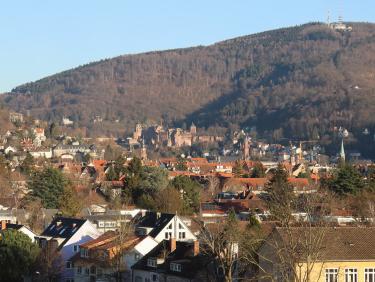Section Invariants and Duality
The research topics of this unit arise from the investigation of continuous structures with geometric and algebraic methods, the connection between representation theory, complex and p-adic analysis, as well as the needs and insights of fundamental science. In teaching, we offer a correspondingly wide range of courses from introductory lectures to specialized seminars.
We are located on the 3rd and 5th floors of the Mathematikon, and look forward to hearing from you via the envelope on the bottom right.

Research Themes
Topology provides a mathematical framework for studying spaces and continuous maps between spaces. This framework spans much of modern mathematics and is applicable to a wide range of spatial phenomena. In a far-reaching generalization of classical modular forms, the theory of Automorphic Forms investigates the incarnation of algebraic structures such as group actions by analytic objects, linking various fields such as number theory, representation theory and geometry. Mathematical Physics develops mathematical theories to describe elementary and complex physical phenomena, and ensures physical insights through mathematical proof. Algebraic geometry deals with sets of zeros of polynomial equations as an archetype of globally defined geometric spaces.
The unity of this diversity lies in the common perspective on the cross-connections that arises from the focus on the calculation of invariants. In topology, for example, these are properties of spaces that remain invariant under continuous deformations, taking into account geometric aspects such as distance, volume, and curvature. In algebraic geometry, one is interested, among other things, in the characterization of incidences and the general position of certain classes of geometric objects in relation to one another. Mathematical physics, informed by the path integral of quantum theory, and in particular the idea of duality, offers an operational view and makes structural predictions about these invariants. The unifying role of automorphic forms, particularly in the Langlands correspondence, is also based on ideas of duality, and has strong ties to mathematical physics and algebraic geometry.
The fruitful exchange between mathematics and physics is at the heart of the STRUCTURES Cluster of Excellence at Heidelberg University.
A detailed description of the research areas can be found on the linked pages of the Faculty of Mathematics and Computer Science, and further information on current projects and job opportunities on the pages of the individual research groups.
Teaching
In addition to contributions to the basic instruction in linear algebra, analysis and higher mathematics, the sections regularly offers the following course sequences:
- Differential Topology 1+2
- Algebraic Topology 1+2
- Complex Variables
- Modular Forms 1+2
- Einführung in die Geometrie
- Algebraic Geometry 1+2
- Lie groups and representation theory 1+2
- String Theory 1+2
- Complex manifolds
For up-to-date information, including seminars, we refer to the “LSF” course catalogue, the “heiCO” campus management system, Müsli and MaMpf, the faculty's homepage, and the pages of the research groups. For undergraduate theses, you are asked to please directly get in touch with a supervisor qualified by the faculty.
Historical Perspective
The prestigious tradition in the field of topology at the Mathematical Institute of Heidelberg University was founded by Herbert Seifert and continued by Albrecht Dold, Dieter Puppe and Matthias Kreck. The name Seifert is associated with fundamental concepts such as Seifert fiber spaces, Seifert surfaces in knot theory and the Seifert-van Kampen theorem. Dold's discoveries in algebraic topology, including the Dold-Thom theorem, the Dold-Kan correspondence, Dold fibrations, Dold manifolds, and the general theory of orientation classes are regularly used today. His fixed point theorem found applications in economics. Puppe's work shaped modern stable homotopy theory, while Kreck's contributions span the differential topology of 4- and higher-dimensional manifolds to stratified spaces via his concept of stratifolds.
Heidelberg's reputation as an internationally recognized focus in the field of automorphic forms is based on the many years of work by Hans Maaß in the post-war period and was later fueled by researchers such as Eberhard Freitag, Michael Rapoport, Winfried Kohnen and Rainer Weissauer. Today, the name Maaß is primarily associated with the waveforms named after him, which he introduced to establish a connection between the theory of modular forms and number theory. But even before Maaß, research in this area was already being carried out in Heidelberg. A prominent example is the investigation of Fuchsian groups, which are important for the theory of modular forms, by Lazarus Fuchs towards the end of the 19th century.




